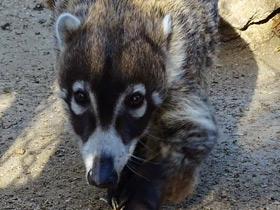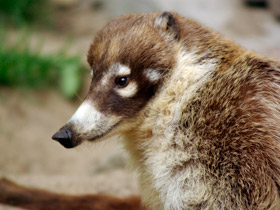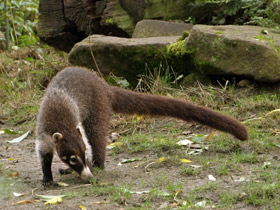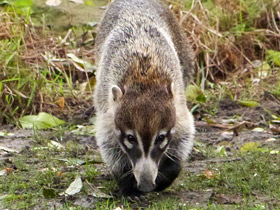The white-nosed coati or the coatimundi (Nasua narica)
The white-nosed coati (Nasua narica), also known as the coatimundi (/koʊˌɑːtɪˈmʌndi/), is a species of coati and a member of the family Procyonidae (raccoons and their relatives). Local Spanish names for the species include antoon, gato solo, pizote, and tejón, depending upon the region. It weighs about 4–6 kg (8.8–13.2 lb), and the nose-to-tail length of the species is about 110 cm (3.6 ft) with about half of that being the tail length. However, small females can weigh as little as 3.1 kg (6.8 lb), while large males can weigh as much as 9 kg (20 lb).
Nasua narica is a carnivorous mammal of the Procionidae family.
Nasua narica inhabits the forests of southwestern North America and Central and South America, from southeastern Arizona through Mexico and Central America to western Colombia and Ecuador.
It can be found in a wide variety of habitats: subtropical and tropical forests in plains and lowlands, arid mountainous areas from the ocean coast to 3,500 metres above sea level. It also occasionally wanders into fields, but does not usually stray far from bodies of water.
Nasua narica is small, with a body length ranging from 41-67 cm and a tail length of 32-69 cm and an average weight of 3-5 kg, but individuals weighing up to 11 kg can be found, with males almost always twice as large as females. The colouring of the Nasua narica is greyish-brown or black on the upper body and whitish underneath. The snout of this predator is elongated, with a narrow, flexible nose, very flexible at the end (hence the name "Nasua") and small ears.
Adult male Nasua narica are active both at night and during the day, but other animals lead a diurnal lifestyle. It is not uncommon for adult Nasua narica to climb into shaded areas during the hot hours of the day and sleep there for several hours while waiting for the heat to pass. The Nasua narica is a good tree climber, balancing and "sticking" to branches with its tail. Most nights are spent in the treetops, fleeing from predators.
Although the Nasua narica spends a lot of time on the ground in search of food, it is also a very good tree climber and swimmer!
It is a hunched species, with forelegs shorter than hind legs and black in colour. Nasua narica has five toes on each foot, armed with curved, non-tractive claws, and the soles of the feet are bare.
The Nasua narica is a carnivorous animal that feeds mainly on insects. It has strong molars and large predatory teeth. Nasua narica feed mainly on the ground. Sometimes they walk up to 2 km a day in search of food. Most of the time, Nasua narica forage for insects, their main food.
When foraging, they forage on the forest floor with their long, agile nose, sniffing vigorously and fanning the leaves, looking for beetles, spiders, scorpions, ants, termites, various larvae, millipedes, bird eggs and even land crabs; they also capture rodents, lizards, snakes and frogs. When it grabs its prey, the Nasua narica will claw it to the ground and then kill it with a bite to the head.
During the fruit ripening season, the Nasua narica feeds on the fruit for a long time and with apparent pleasure, often returning to the same fruit tree again and again. Sometimes, Nasua narica also feed on other parts of the plant: roots and nuts. They usually choose only the tender fruits, especially those of the prickly pear.
Unlike other species in the family, the Nasua narica not only lives solitary, but also in groups of 5-6 and sometimes up to 40 individuals. Groups usually consist of sexually mature females and their pups, including young males up to two years of age. In these groups, Nasua narica together are better able to protect their young from predators.
When communicating with each other, several methods of communication are used.
Vocal or vocal communication is relatively well developed, much better than in the raccoon. Their repertoire includes sounds such as wheezing, grunts, peculiar cries, moans and squeaks. Young Nasua narica are very playful and spend a lot of time playfully hunting or engaging in noisy fights with each other.
The territories of Nasua narica groups are about 1 km in diameter, overlap with those of other groups and include the territories of several adult males. New groups are formed as a result of the splitting of older groups, which seems to explain the lack of aggression between neighbouring groups.
In territorial conflicts, males use their sharp claws and fangs. Sexually mature adult males live in isolation, occupying a certain area. They mark their boundaries by spraying urine or applying secretion from anal scent glands to the surfaces of various substrates. The anal glands of Nasua narica are highly modified compared to those of other raptor species. They have a glandular region located along the upper edge of the anus, consisting of a series of sacs that open with 4 or 5 incisions on the sides.
From January to March, when the mating season begins, sexually mature single males join the family group and compete with each other for the attention of the females. Normally, only the strongest male will be able to remain in the family group and only he will be able to mate with the females. However, shortly after the end of the mating period, the females chase him away because he is often aggressive towards the offspring and sometimes even kills them.
Pregnancy lasts 77 days. Shortly before giving birth, the female leaves the group and makes a burrow for her future offspring. It is usually found in the hollow of a tree, in a depression in the ground, among rocks, but more often in a rocky hollow in a wooded canyon.
Newly hatched young weigh between 100 and 180 grams and are totally dependent on their mother, who leaves them alone in the nest for the first few weeks just to forage for food. The young open their eyes at 11 days of age. When they are a little older and stronger, they return to the family group with their mother.
The female continues to feed them with milk until they are four months old, when they switch entirely to solid animal food. At this time, the male that has mated with the females in this group reappears and is reunited with the young for several consecutive days.
The young remain with their mother almost until their next birth. As soon as the young males reach two years of age, they leave the group and remain isolated, while the females usually remain in the group. Young animals reach adulthood at 15 months, with males reaching sexual maturity at three years and females at two years. Nasua narica have a life expectancy of about 14 years in captivity, but in the wild it is usually half that.
Conservation
The International Union for Conservation of Nature lists both the white-nosed coati and the South American coati as least concern. However, the coati is an endangered species in New Mexico.
















































